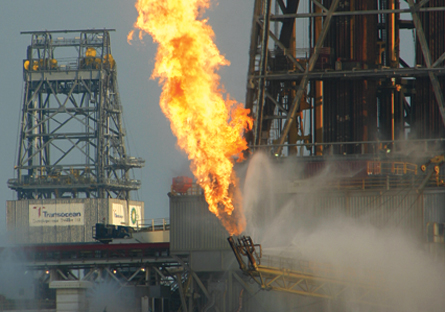Gases dominate Gulf’s subsea plumes
Microbes are degrading easily-digested hydrocarbons first, a study finds
The plumes of oil that spewed into the Gulf of Mexico’s depths this spring and summer in the aftermath of the BP Deepwater Horizon blowout were actually only about one-third oil, scientists estimate, with the remainder consisting of natural gas.

Research reported online September 16 in Science found that in June, marine microbes were primarily feeding on propane and ethane in the oil plumes.
“We estimate that there’s about two times as much gas sitting in those subsurface plumes as there is oil — and there’s about a million barrels of oil in them,” says David Valentine of the University of California, Santa Barbara, speaking by phone from a National Oceanic and Atmospheric Administrationresearch vessel in the Gulf.
Chemists had been trying to estimate how much oxygen might disappear as microbes began degrading BP’s spilled oil. It now turns out oil is only a tiny part of the issue. “Probably 66 to 75 percent of the oxygen loss — maybe even a bit more — will ultimately come from bacterial metabolism of the gases,” Valentine projects.
Significantly, microbes were not consuming much methane, a gas molecule that is biochemically much harder to crack than propane and ethane. That observation suggests that the most easily digested components of the plumes were the first to be attacked by microorganisms.
The new research “is quite solid and something people will be taking seriously,” says Benjamin Van Mooy, a chemical oceanographer at the Woods Hole Oceanographic Institution in Massachusetts. He was part of a team that recently reported finding substantial undegraded oil in the Gulf’s deep-sea plumes.
Van Mooy expressed surprise at the amount of gas that the new report measured in the plumes. But then again, he adds, “It’s amazing how little we still know about what’s down there,” especially regarding entrained BP gas. “This is the first paper that really takes that issue head-on.”
Terry Hazen of Lawrence Berkeley National Laboratory in California and his colleagues recently reported finding substantial microbial degradation of a particular fraction of the spilled oil called n-alkanes in subsea plumes. He says that the work by the Woods Hole team and the authors of the new Science paper doesn’t contradict his group’s findings. “They’re all quite consistent,” he says. Each group looked at different hydrocarbons at different times, and sometimes in different plumes. The environment is dynamic, he notes, and truly understanding what’s happening will take a lot more work.
More data may emerge from bug traps that Hazen’s group began setting in the Gulf on August 26. The researchers baited polymer beads with BP oil and set the traps at various depths from the surface down to where the plumes have been traveling. At prescribed intervals, the researchers are now retrieving the traps to see what types of microbes they’ve attracted and how successfully the organisms have been breaking apart the hydrocarbons.
One big concern since the initial discovery of deep-sea hydrocarbon plumes has been what will happen to oxygen concentrations near the seabed. Some scientists have questioned whether fish-suffocating dead zones might develop. But a September 7 federal study looked for evidence of such oxygen deprivation in plume zones and found none.
Based on four months of sampling data through August 9, “Oxygen levels have dropped by about 20 percent from their long-term average in this area of the Gulf,” said Steve Murawski, chief science advisor to NOAA’s Fisheries Department and head of the largely federal interagency Joint Analysis Group on the BP spill. Oxygen levels in plume zones have stabilized, he said, and “would have to decrease another 70 percent in order to be classified a dead zone.”







